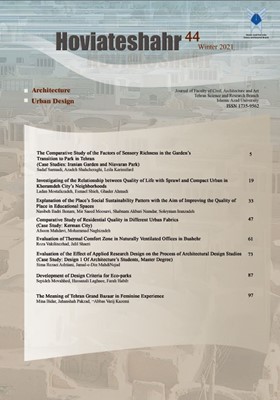Comparative study of residential quality in different urban fabrics (Case study: Kerman)
Subject Areas : urbanismAfsoon Mahdavi 1 , Mohammad Naghizadeh 2 *
1 - Ph.D candidate, science and Research Branch, Islamic Azad University, Tehran, Iran.
2 - Assistant professor, department of art and architecture, science and research branch, Islamic Azad University, Tehran, Iran
Keywords: Quality of environment, homogeneous, Residence, Building code, district,
Abstract :
Residential areas are important factors in improving the quality of urban life, and since "home" is considered as a place for living and serenity, from the early days of human civilization, a variety of designs, plans and ideas were provided to improve the quality of houses and people are always seeking ways to add comfort and welfare to their lives. Quality can be expressed by defining the manner of phenomenon in different subjects, and the manner of phenomena is determined by the human perception, which is built based on the understanding of each phenomenon. Based on the status of human perception and definition on each phenomenon, this study focuses on developing a conceptual model by considering a variety of factors influencing the quality of life in urban contexts. Whether for investment or just providing houses for people with low income, the growth of real estate market and increasing rate of housing construction, without any regard to the standards of the desirable quality for these living spaces, form undesirable and in harmonious urban fabrics and neighborhoods that has made the image of cities unseemly; in addition, these houses can’t provide the desirable comfort for residents and citizens. Paying no attention to these issues and their continuous existence in housing construction, has resulted in the loss of real sense for living in cities and gave inconspicuous meaning to the role of residential fabrics in improving mental health and good human relations. Therefore, studying the quality of housing in order to develop strategies for improving the quality of urban housing is critical for the improvement of human housing and living conditions. A brief body of literature, mostly in countries like Netherlands, America, and England, and some in Iran, has focused on housing quality; their methods, evaluations techniques, characteristics and standards have been examined in this research. Compared to previous studies, this study tried to develop a combined model of all effective components on the quality of housing in different dimensions such as social, cultural, economic, psychological-mental, and physical. The aim of this qualitative study is to find practical ways to improve the quality of residential environments, and the used method in this study is analytical. For this research, a questionnaire with 98 questions was developed; the validity of this questionnaire was approved by social scientists and city experts and the reliability was approved by using Cronbach’s alpha method. This questionnaire was randomly distributed among 384 individuals (who were chosen by using Cochran Formula), and obtained results from these questionnaires were analyzed by means of Pearson correlation test and linear regression model. At the end, by comparing the residential situation in different urban fabrics of Kerman, turned out that Al-Ghadeer neighborhood which is located in the city's new development site, has the most quality, and the lowest rank of quality of living belongs to Tah-Bagh Laleh neighborhood, which is located in the old city texture, and totally the quality of residential areas in urban fabrics in Kerman result was good.

